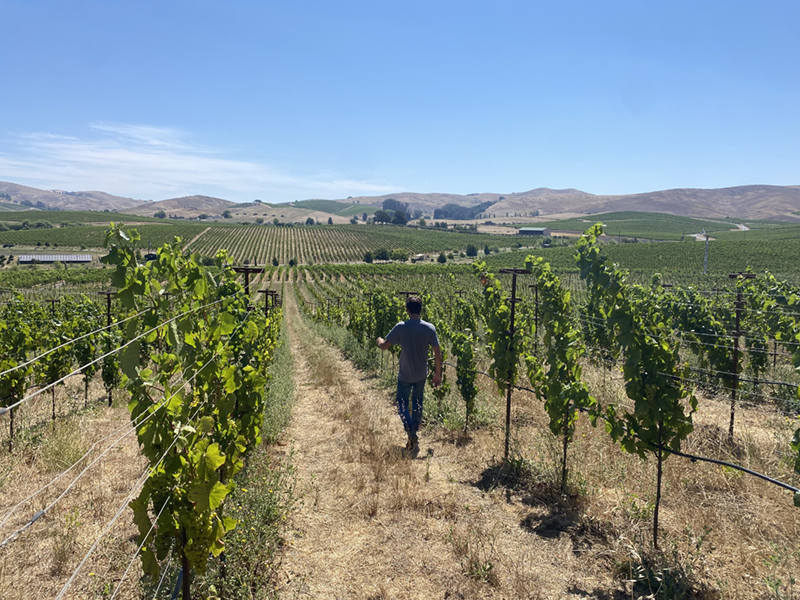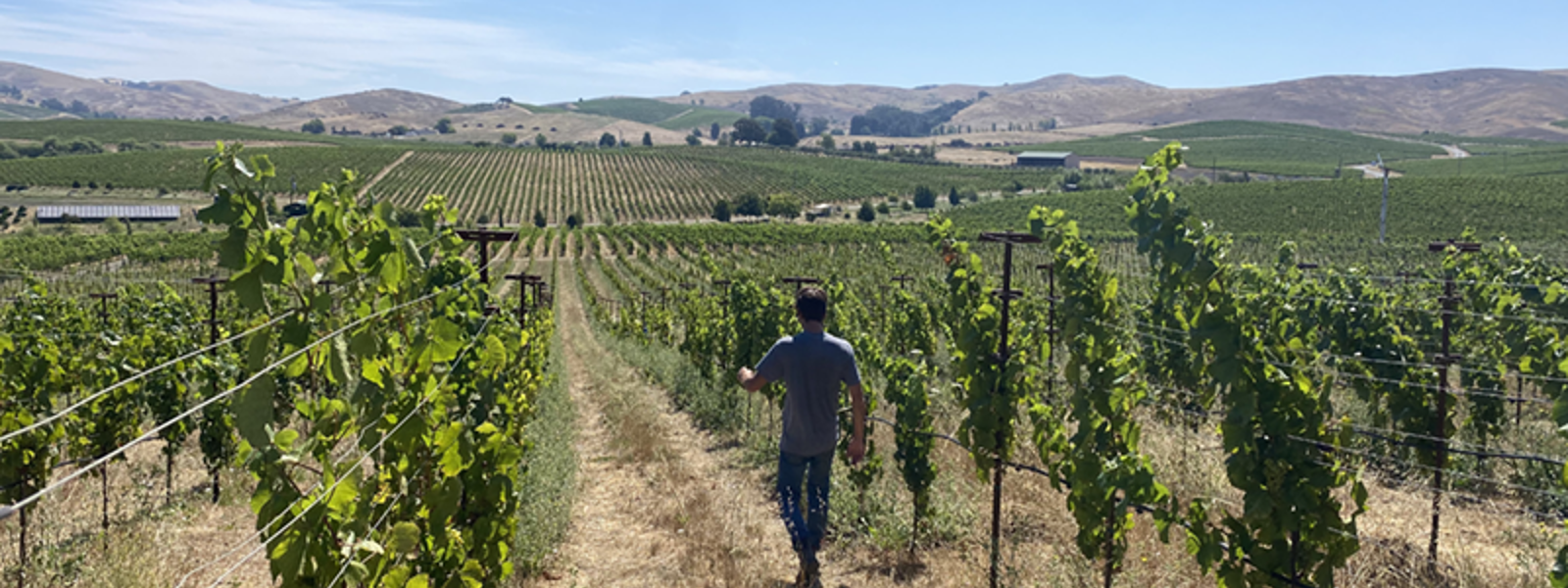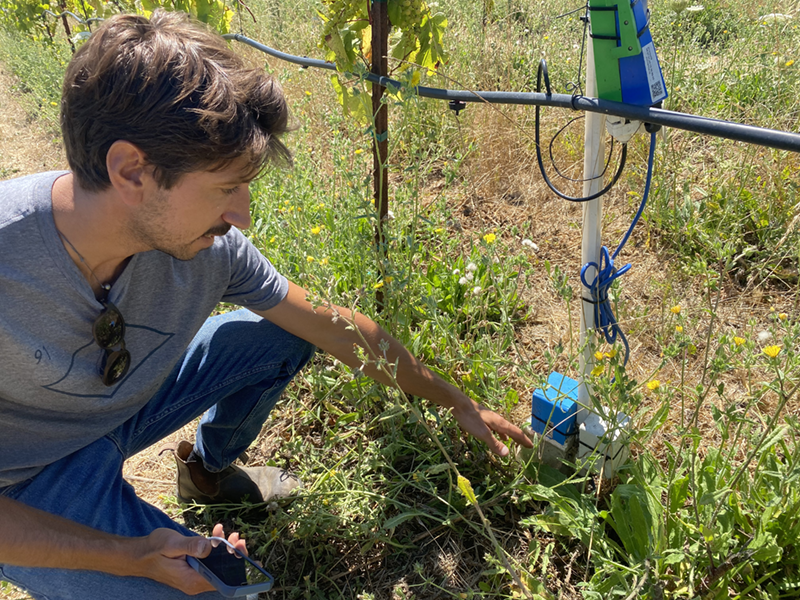Climate concerns inspire innovation in wine vineyards

Bernat Sort Costa of Grgich Hills Estate walks a vineyard to examine grapevine, soil and moisture conditions.
Photo/Natalie Hanson


Photo/Natalie Hanson
By Natalie Hanson
As he does most mornings, Bernat Sort Costa walked through 160 acres of grapevines in American Canyon, checking on the largest of five vineyards cultivated by Napa Valley wine producer Grgich Hills Estate.
Growers in the wine region are embracing innovations to monitor vineyard conditions amid California’s hotter, drier climate. But Costa said he still employs a hands-on and “boots-on-the-ground” approach for evaluating grapevine health, as well as soil and moisture conditions in the vineyard of chardonnay and sauvignon blanc.
Costa, a winemaker and biologist who serves as Grgich’s regenerative organic research manager, pointed to the soil and described how it cracked beneath his feet due to high deposits of clay. He explained how that is a challenge for retaining water, while noting that the no-till and “super low-tech” farming operation uses mulch to boost soil moisture.
But things are changing in this vineyard and others in the Napa and Sonoma Valley wine regions, where growers are employing sustainable farming practices and technology to adapt to climate change.
Grgich Hill Estate is testing sensor technology designed by Agrology, a Sonoma and Alexandria, Virginia, company that promotes regenerative farming and data tools to help farmers reduce their carbon footprint. It employed the Agrology sensors to measure vineyard soil moisture and carbon dioxide levels.
To increase wine productivity, quality and sustainability amid the stresses of climate change affecting California wine regions, growers are also partnering with researchers who are working on developing new rootstocks and scions for warmer conditions.
“Climate change will undoubtedly alter how, what and where we grow grapes, and breeding will play a crucial role in adapting to these changes,” said Luis Diaz-Garcia, a professor of viticulture and enology at the University of California, Davis. He is leading rootstock breeding efforts to meet future needs of growers.
While wineries praise longstanding winemaking traditions, and professionals celebrate their abilities to evaluate vineyard conditions by look and feel, the California wine sector is adapting and employing technology in the face of sustained droughts of recent years and heat waves such as those experienced this summer, industry leaders say.
Karissa Kruse, president and CEO of Sonoma County Winegrowers, a regional industry marketing and educational group, said regional growers are using gamma ray technology to analyze soil and precision data software to guide pesticide applications. They’re also using interactive tools to monitor weather stations for heat and moisture data for harvest and irrigation decisions.
In addition, Kruse said Sonoma County Winegrowers is partnering with the California Land Stewardship Institute in deploying a greenhouse emissions and carbon-sequestration accounting system, COMET-Farm, developed by the U.S. Department of Agriculture Natural Resources Conservation Service and Colorado State University.
The soil data sensors tested at Grgich Hill Estate vineyards were distributed with the help of Napa Green, a regional group that promotes sustainable winemaking and grape growing. The sensors check carbon dioxide levels in vineyard canopies and measure CO2, moisture and soil temperature.
Napa Green vineyard manager Ben Mackie said growers have lots of new tools at their disposal. Some use water meters equipped with online tracking to decide when to water their vines or rely on satellite imaging to track plant respiration.
“There’s some modeling systems people use, like climate monitoring systems using weather forecasts and soil moisture levels,” Mackie said. “They are also using (artificial intelligence) to know when to water next based on that data.”
Agrology’s head of agricultural business development, Jay Radochia, said the company is working with Napa and Sonoma winegrape growers and refining its technology with grower input.
“We’re still learning the indicators in our data set that might lead to quality impacts on plant stress and plant growth,” Radochia said, adding the company is studying how “we tie the soil-health changes to expressions in the vine and the crop and (to) the grape quality and wine quality.”
Pine Ridge Vineyards viticulture director Gustavo Aviña still walks his Napa vineyards each week to check every vine’s water needs. Pine Ridge is also partnering with Napa Green on employing technology and new approaches in water management.
Pine Ridge uses drip irrigation with reclaimed water from the city of Napa used in three of its vineyards. To curb water use, some vineyards now use automatic irrigation systems only at night. Vineyards use evapotranspiration sensors to measure water usage and loss for each vine.
“With all of our irrigation efforts and management, we are saving at least 30% of water and saving time for our irrigators,” Aviña said. “We know technology works and we are utilizing it, but we still think that boots on the ground is always a plus.”
Costa of Grgich Hills Estate said he has confidence in the vineyards’ regenerative farming model, which seeks to address drought and plant diseases and pest dangers that researchers say are increasing in part due to climate change.
In addition, Costa said Grgich Hills is focused on monitoring soil levels and improving diversity of nutrients for each vine. It’s part of regenerative farming, which is encouraged by the Sonoma County Winegrowers. The group hosted a July field day on sustainable winegrape growing to encourage farmers to improve soil health and increase water-holding capacity.
While climate concerns have accelerated technology and innovation, Kruse said growers still rely on personal experience and judgment.
“Overall, the farmers would still say that the best data remains the farmer’s footprints and conversations with their neighbors to learn real-time what is happening and adjustments that should be made, especially in an increasingly complex climate,” she said.
Costa said Grgich Hills, which grows different winegrape varietals on vines ranging from a year old to a century old, will continue evolving to produce wines compatible with growing conditions of a changing climate.
While Costa said he is unsure the operation will stick with the recently employed sensor technology, he said it will stay on top of climate-adaptive innovations while maintaining some of its old-school approach.
“We’re not interested in AI. We’re very boots-on-the-ground oriented,” he added. “But we’re up to date in terms of what research is being done.”
(Natalie Hanson is a reporter in Alameda County. She may be contacted at natalie.hanson96@gmail.com.)




